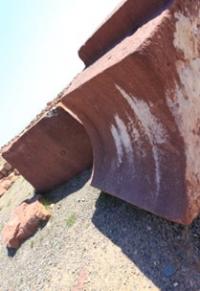You are here
Riddle of Akrytas settlement.

Kazakhstan Travels and Tours.
«Southern Kazakhstan is home to an astonishing sight: the enormous red sandstone ruins of Akyrtas, whose mysterious origins have long baffled historians. This spiritual site has given rise to many legends and is a favourite among all kinds of pilgrims. It's reputed not only to have health-giving properties but also to help people see into their futures. Adding to the riddles surrounding these impressive stone structures, the site is also said to be visited by UFOS»
Kazakhstan Travel Map.
The ruins of Akyrtas, which lovers of antiquity find so amazing, are located 40 kilometres to the east of modern-day Taraz. These huge mounds of red sandstone jutting out of the earth are grouped in several separate lines.
An experienced eye might distinguish the contours of buildings, columns and towers, while those with a vivid imagination may see a castle whose walls leap out into the sky. The vast territory across which the red sandstone blocks are spread bears witness to the size of the grandiose construction that once stood there.
One of the conundrums this site presents is that mega-lithic constructions of this type are not usual for the Kazakh steppe, so what kind of building could this have been and for what purpose may it have been built?
Explorers have long sought to tackle these questions, but there are still no firm answers. Studies of Akyrtas began more than 130 years ago. The Russian artist Mikhail Znamenskiy was the first in modern times to take an interest in it when he visited the ruins in 1864 as a member of a military expedition headed by the governor of the Turkestan region, General Mikhail Chernyayev, and he did some interesting sketches of the surrounding views and of the remains of the walls.
Three years later, the famous Orientalist Petr Lerkh examined the monument. He drew up a preliminary description, measured some sections and published some information about the ruins of Akyrtas collected by Buddhist monk Chang Chun, to whom Genghis Khan once turned hoping to find the secret of eternal life.
At the beginning of the XIIIth century as the monk was travelling from China via Sayram to Samarqand he passed through Akyrtas, but found only the ruins of this majestic construction. Petr Lerkh thought Akyrtas had once been a Buddhist monastery. In 1885 the Russian explorer Dmitriy Ivanov collected a rich vein of material about Akyrtas and published a long article in a magazine called News of the Imperial Russian Geographic Society.
"The huge stones, the gigantic nature of this construction, the daring design, the skill and care with which it has been executed and, finally, this bulk in the dry semi-desert, which now looks so isolated, combine to make us view Akyrtas as one of Turkestan's magnificent ancient architectural constructions," he said.
"Huge funds must have been required for such Cyclopean design, and an enormous slave force would have been needed as well as all those riches. Only a powerful potentate could have undertaken such a project."
In 1893 another famous Orientalist, Vasiliy Bar-told, visited Akyrtas. He gathered legends about the monument and proposed his own theory: that this was a monastery of Nestorian Christians.
Interest in Akyrtas never faded, and explorers continued to visit the site. New assumptions emerged in Soviet times that Akyrtas was either a palace-cum-fortress built in the 8th-9th centuries, or a caravanserai, or the unfinished headquarters of the Qarluqs, who ruled the Zhetysu region in the 8th-10th centuries and invited Arab architects into the area to design buildings.
German explorer Burchard Brentjes had another theory about Akyrtas. He suggested that Akyrtas was built by order of the Arab commander Kuteiba ibn Muslim in 714-715 AD as his residence in the north of the region he ruled.
This theory is based on the premise that when he became ruler of the area he began to fear for the safety of his family and ordered them to be brought to him. However, while his relatives were on their way to Merv (an ancient city in modern-day Turkmenistan), Kuteiba was killed, and Akyrtas remained unfinished.
There are, then, many different theories about when and why Akyrtas was built. Research undertaken by specialists from Kazakhstan's Institute of Archaeology in 2004 made it possible to open up the walls, which have extremely deep foundations of some 1.5 metres, and start preparations to even- tually set up an open-air museum.
Interestingly, nothing other than an ancient clay water-pipe was found in Akyrtas: no ceramics, no remains of the roofing, no traces of fireplaces - nothing to confirm that people lived there.
Everything suggests that construction was unfinished, even though the extent of the walls indicates that it was in the final stages. Explorers have detected similarities in the planning of Akyrtas with the architecture of the Middle East.
The design is very similar to the palaces of Samara in modern-day Iraq and to buildings in Syria such as the summer residence of the Arab caliphs and the magnificent Qasr al-Hayr al-Sharqi palace.
Recalling the early clashes of the Arabs and the Persians, we remember that the Arab army came up against the fortresses in which local people were hiding along with the military garrison.
Akyrtas may well, then, be a palace-cum-fortress which was supposed to become the ruler's summer capital. That ruler could have been a Qar-luq kagan (ruler), since the Qarluqs ruled western Zhetisu from 766 to 893.
Theories abound, but the mystery of Akyrtas remains unsolved. Perhaps that is the key to its attraction.
Authority:
Karl Baipakov and Dmitriy Voyakin. Magazine "Tengri" № 2, 2008/







